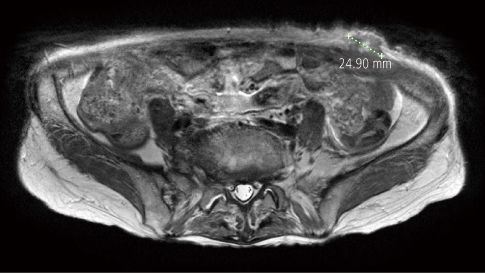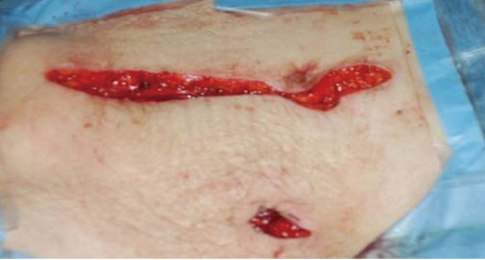Korean J Obstet Gynecol.
2011 Jul;54(7):395-397. 10.5468/KJOG.2011.54.7.395.
Port-site metastasis of advanced primary peritoneal cancer after laparoscopic peritoneal biopsy: A case report
- Affiliations
-
- 1Department of Obstetrics and Gynecology, Samsung Medical Center, Sungkyunkwan University School of Medicine, Seoul, Korea. ds123.bae@samsung.com
- KMID: 2274057
- DOI: http://doi.org/10.5468/KJOG.2011.54.7.395
Abstract
- Due to the advancement in laparoscopic surgery in gynecology, laparoscopic surgery of patients with gynecologic malignancy is widely used. A 69-year-old woman who had elevated serum level of CA-125 and malignant ascites was transferred from general surgery after laparoscopic peritoneal biopsy. She complained about 2.5 cm sized abdominal wall mass which developed only 1week after surgery. With the impression of ovarian cancer with port-site metastasis, we performed debulking operation and abdominal wall mass excision. The final pathology confirmed primary peritoneal serous papillary adenocarcinoma. Whenever a female patient has elevated serum level of CA-125 and ascites cytology shows adenocarcinoma, she should be referred to gynecologic oncologists first. And considering the primary peritoneal or ovarian cancer, primary debulking operation by gynecologic oncologist is recommended.
MeSH Terms
Figure
Reference
-
1. Kruitwagen RF, Swinkels BM, Keyser KG, Doesburg WH, Schijf CP. Incidence and effect on survival of abdominal wall metastases at trocar or puncture sites following laparoscopy or paracentesis in women with ovarian cancer. Gynecol Oncol. 1996. 60:233–237.2. Abu-Rustum NR, Rhee EH, Chi DS, Sonoda Y, Gemignani M, Barakat RR. Subcutaneous tumor implantation after laparoscopic procedures in women with malignant disease. Obstet Gynecol. 2004. 103:480–487.3. Childers JM, Aqua KA, Surwit EA, Hallum AV, Hatch KD. Abdominal-wall tumor implantation after laparoscopy for malignant conditions. Obstet Gynecol. 1994. 84:765–769.4. Huang KG, Wang CJ, Chang TC, Liou JD, Hsueh S, Lai CH, et al. Management of port-site metastasis after laparoscopic surgery for ovarian cancer. Am J Obstet Gynecol. 2003. 189:16–21.5. Chung MJ, Lee JM, Kim YJ, Park IS, Cho YL, Lee YS. Trocar-site metastasis after laparoscopic gynecologic oncologic surgery. Korean J Obstet Gynecol. 2007. 50:117–125.6. Rosenoff SH, DeVita T Jr, Hubbard S, Young RC. Peritoneoscopy in the staging and follow-up of ovarian cancer. Semin Oncol. 1975. 2:223–228.7. Jennings TS, Dottino P, Rahaman J, Cohen CJ. Results of selective use of operative laparoscopy in gynecologic oncology. Gynecol Oncol. 1998. 70:323–328.8. van Dam PA, DeCloedt J, Tjalma WA, Buytaert P, Becquart D, Vergote IB. Trocar implantation metastasis after laparoscopy in patients with advanced ovarian cancer: can the risk be reduced? Am J Obstet Gynecol. 1999. 181:536–541.9. Thomas CG. Tumor Cell Contamination of the Surgical Wound: Experimental and Clinical Observations. Ann Surg. 1961. 153:697–704.10. Wang PH, Yuan CC, Lin G, Ng HT, Chao HT. Risk factors contributing to early occurrence of port site metastases of laparoscopic surgery for malignancy. Gynecol Oncol. 1999. 72:38–44.11. Choi CH, Kim TJ, Kim WY, Ahn GH, Lee JW, Kim BG, et al. Papillary serous carcinoma in ovaries of normal size: a clinicopathologic study of 20 cases and comparison with extraovarian peritoneal papillary serous carcinoma. Gynecol Oncol. 2007. 105:762–768.
- Full Text Links
- Actions
-
Cited
- CITED
-
- Close
- Share
- Similar articles
-
- Incidentally Found Port Site Metastasis followings Laparoscopic Radical Nephrectomy for a Renal Cell Carcinoma
- Port-site Metastasis Following Laparoscopic Cholecystectomy
- Unusual Peritoneal Metastasis of Late Recurrent Uterine Cervical Cancer: A Case Report and Literature Review
- A Case Report of Primary Peritoneal Cancer
- Peritoneal and gastric metastasis from invasive lobular breast carcinoma: a case report



